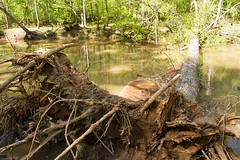 Increased flash-flooding erodes stream banks, felling trees.
Increased flash-flooding erodes stream banks, felling trees.
Photographer: Sam Sheline, courtesy of NatureServeThe natural processes of erosion and sedimentation are most evident in the floodplains and floodways of streams.
Streams erode sediment from the steep, concave bluffs on the outsides of stream bends, and deposit it downstream. Some sediments are deposited as point bars on the insides of stream bends, while others are deposited on other surfaces of the floodway and floodplain.
These processes happen every day, but they happen on a larger scale during and after floods. As stream waters overflow their banks, they replenish the floodplain with sediments from upstream.
Over the course of years, a stream can meander through its floodplain, acting as an agent of natural disturbance. Stream channels are continuously changing through these natural processes.
On a smaller scale, erosion and sedimentation processes occur everywhere, including hillslopes. When rainwater washes over a steep or convex upper slope, it erodes sediments and carries them downslope to deposit them in flatter or more concave areas, like toeslopes.
Gravity and weather can work together on slopes to transport larger amounts of material downslope. This movement can happen quickly in avalanches or mudslides, or slowly, when frost-heaving and gravity gradually cause soil and rocks to move downslope.


